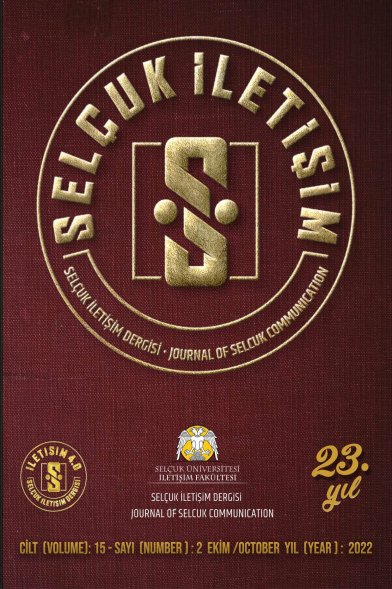Kullanıcı Deneyimi ve Kişiselleştirme Bağlamında Bir Dijital Platform İncelemesi
Dijital Platform, Netflix, Kullanıcı Deneyimi, Kişiselleşitrme
___
- Alben L (1996) Quality of experience: defining the criteria for effective interaction design, interactions, 3(3), 11-15. Chorianopoulos K (2008) Personalized and Mobile Digital TV Applications, Multimedia Tools and Applications, 36(1-2), 1-10. Cosley D, Lam, S. K., Albert, I., Konstan, J. A., & Riedl, J. (2003, April). Is seeing believing? How recommender system interfaces affect users' opinions. In Proceedings of the SIGCHI conference on Human factors in computing systems (pp. 585-592). Creswell, J. W. (2017). Araştırma deseni: Nitel, nicel ve karma yöntem yaklaşımları. Eğiten Kitap. DIS, I. (2010). 9241-210: 2010. Ergonomics of human system interaction-Part 210: Human-centred design for interactive systems (formerly known as 13407). International Standardization Organization (ISO). Switzerland. Flayelle, M., Canale, N., Vögele, C., Karila, L., Maurage, P., & Billieux, J. (2019). Assessing binge-watching behaviors: Development and validation of the “Watching TV Series Motives” and “Binge-Watching Engagement and Symptoms” questionnaires. Computers in Human Behavior, 90, 26-36. Forlizzi, J., & Battarbee, K. (2004, August). Understanding experience in interactive systems. In Proceedings of the 5th conference on Designing interactive systems: processes, practices, methods, and techniques (pp. 261-268). Herbas Torrico, B., & Frank, B. (2019). Consumer desire for personalisation of products and services: cultural antecedents and consequences for customer evaluations. Total Quality Management & Business Excellence, 30(3-4), 355-369. Kazienko, P.,&Adamski, M. (2007). AdROSA—Adaptive personalization of web advertising. Information Sciences, 177(11), 2269-2295. Konstan, J. A., & Riedl, J. (2012). Recommender systems: from algorithms to user experience. User modeling and user-adapted interaction, 22(1-2), 101-123. McNee, S. M., Riedl, J., & Konstan, J. A. (2006, April). Being accurate is not enough: how accuracy metrics have hurt recommender systems. In CHI'06 extended abstracts on Human factors in computing systems (pp. 1097-1101). McNee, S. M., Riedl, J., & Konstan, J. A. (2006, April). Making recommendations better: an analytic model for human-recommender interaction. In CHI'06 extended abstracts on Human factors in computing systems (pp. 1103-1108). Murray, K. B., & Häubl, G. (2008). Interactive consumer decision aids. In Handbook of marketing decision models (pp. 55-77). Springer, Boston, MA. Murray, K. B., & Häubl, G. (2009). Personalization without interrogation: Towards more effective interactions between consumers and feature-based recommendation agents. Journal of Interactive Marketing, 23(2), 138-146. Murthi, B. P. S., & Sarkar, S. (2003). The role of the management sciences in research on personalization. Management Science, 49(10), 1344-1362. Novak, A. N. (2017). Narrowcasting, Millennials, and the personalization of genre in digital media. The Age of Netflix: Critical Essays on Streaming Media, Digital Delivery and Instant Access. Jefferson, NC: McFarland, 162-181. Ozok, A. A., Fan, Q., & Norcio, A. F. (2010). Design guidelines for effective recommender system interfaces based on a usability criteria conceptual model: results from a college student population. Behaviour & Information Technology, 29(1), 57-83. Panda, S., & Pandey, S. C. (2017). Binge watching and college students: motivations and outcomes. Young Consumers. Pazzani, M. J. (1999). A framework for collaborative, content-based and demographic filtering. Artificial intelligence review, 13(5-6), 393-408. Petrison, L. A.,Blattberg, R. C., &Wang, P. (1997). Database marketing: Past, present, andfuture. Journal of Direct Marketing, 11(4), 109-125. Pierrakos, D., Paliouras, G., Papatheodorou, C., & Spyropoulos, C. D. (2003). Web usage mining as a tool for personalization: A survey. User modeling and user-adapted interaction, 13(4), 311-372. Pittman, M., & Sheehan, K. (2015). Sprinting a media marathon: Uses and gratifications of binge-watching television through Netflix. First Monday, 20(10). Pu, P., Chen, L., & Hu, R. (2012). Evaluating recommender systems from the user’s perspective: survey of the state of the art. User Modeling and User-Adapted Interaction, 22(4-5), 317-355. Roberts, M. L.,&Zahay, D. (2012). Internet marketing: Integrating online and offline strategies. Cengage Learning. https://books.google.com.tr/books?hl=tr&lr=&id=6doKAAAAQBAJ&oi=fnd&pg=PR7&dq=Roberts+ve+Zahay,+2012&ots=SBIYm4JMdV&sig=Mx5euds3cxpW3OHCk5_ZsFlkLRY&redir_esc=y#v=onepage&q=Roberts%20ve%20Zahay%2C%202012&f=false Sevim, S., & Sevim, B. A. (2019). İZLEYİCİNİN NABZINI TUTMAK: BÜYÜK VERİ, TAVSİYE ALGORİTMALARI VE NETFLIX. JAMMO ISSN 2146-3328, 10(36), 560-569. Schubert, P., & Koch, M. (2002). The power of personalization: Customer collaboration and virtual communities. AMCIS 2002 Proceedings, 269. Shim, H., & Kim, K. J. (2018). An exploration of the motivations for binge-watching and the role of individual differences. Computers in Human Behavior, 82, 94-100. Taylor, B. (2018). To see the future of competition, look at netflix. Harward Business Review. https://hbr.org/2018/07/to-see-the-future-of-competition-look-at-netflix Tseng, M. M., Jiao, R. J., & Wang, C. (2010). Design for mass personalization. CIRP annals, 59(1), 175-178. Vesanen, J. (2007). What is personalization? A conceptual framework. European Journal of Marketing. Wind, J.,&Rangaswamy, A. (2001). Customerization: The next revolution in mass customization. Journal of interactive marketing, 15(1), 13-32. Yıldırım, A., & Şimşek, H. (2016). Sosyal Bilimlerde Nitel Araştırma Yöntemleri (10. Baskı) Ankara: Seçkin Yay.
- Yayın Aralığı: 2
- Başlangıç: 1999
- Yayıncı: Selçuk Üniversitesi İletişim Fakültesi
Yeşil Reklamlarda Tüketicinin Bilinçlendirilmesine Yönelik Çevreci Söylemlerin Analizi
Siyasal Aktivizm Aracı Olarak Twitter: 2019 Venezuela Başkanlık Krizi Üzerine Bir İnceleme
Bulgaristan’da Komünist Rejim Sonrası Türklere Yönelik Propaganda ve Algı Çalışmalarına Örnekler
Selcen ÖZYURT ULUTAŞ, Rengin YAVUZ
Genç Tüketicilerin Reklamda Ünlü Kullanımına Yönelik Tutumları
A. Mücahid ZENGİN, Nuri Paşa ÖZER
Online Kurumsal İtibar Yönetimi: CEO’ların Twitter Kullanımı Üzerine Nitel Bir Araştırma
Televizyon Haberlerinde Erişilebilirlik Üzerine Bazı Gözlem ve Öneriler
Turizmde Fotoğraf (Fotoğrafçı-Fotoğraflanan Etkileşimi Üzerine Bir Araştırma)
